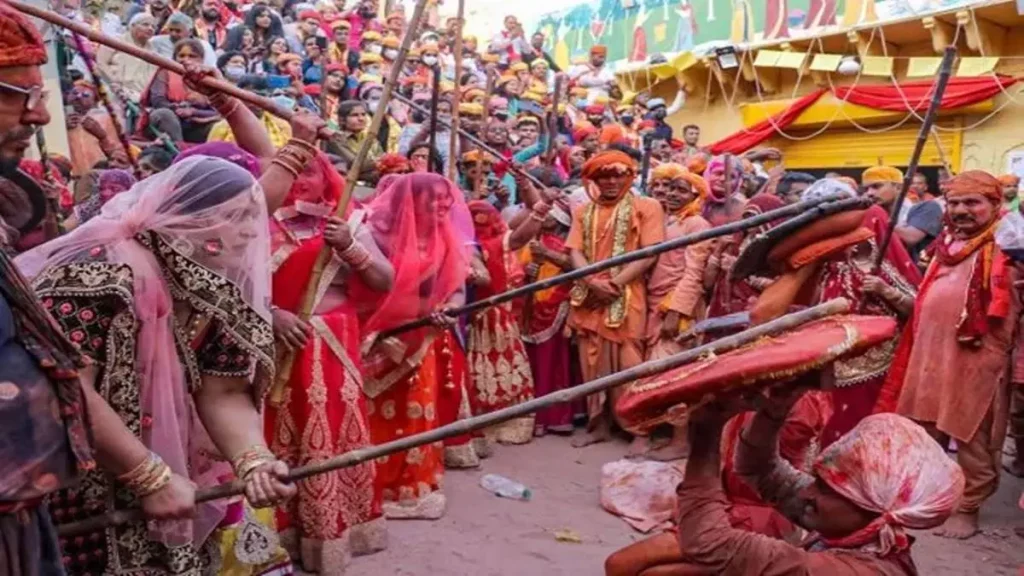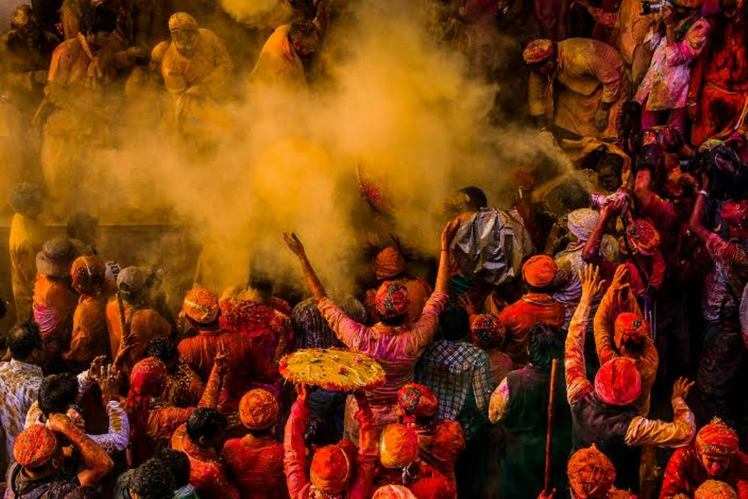The celebration of Holi in India is a truly remarkable spectacle. It is celebrated in India with zeal across all states and includes a wide range of traditions and customs. For instance, Holi is celebrated as Rang Panchmi in Maharashtra, Holla Mohalla in Punjab, Kumaoni Holi in Uttarakhand, and Manjal Kuli in Kerala. Among these types of Holi in different states of India, the most popular and favourite type is that of Lathmar Holi in Uttar Prades. It attracts tourists from all over the country and abroad countries as well.
Contents
What is Lathmar Holi?
Days before the actual celebration of the festival begins, the cities of Barsana and Nandgaon cover themselves in hues of gulal. Lathmar Holi which loosely translates into the festival of sticks and colors truly lives up to its hype.
Lathmar Holi has a mythological and historical significance owing to its association with lord Krishna and goddess Radha. This popular Holi tradition is observed in the Barsana and Nandgaon towns of Mathura, Uttar Pradesh. These culturally rich cities of Uttar Pradesh celebrate the festival of colours in a very unique way where men throw colours at women and women beat them with ‘laths’ or ‘lathi’ in a playful manner. This ‘Barsane wali Holi’ is celebrated in large mass gatherings. It signifies the love, respect, and trust mentioned in Radha-Krishna stories.
Also Read: 10 Facts about Holi That Will Interest You
History of Lathmar Holi: Why do we Celebrate it?
Just like the story of Holika Dahan, there are different reasons why India celebrates Lathmar Holi with great enthusiasm. The tale of its origin holds great significance for the people of the country, especially those living in Barsana and Braj.
Celebrated since times immemorial in Barsana and Nandgaon, Lathmar Holi, which literally translates to Holi with sticks, is observed in the memory of Radha Krishna. According to different mythologies and folklore, Radha was born in Barsana village and Krishna was born in Nandgaon village. As the legend goes, Krishna used to come to Barsana to smear colours on Radha and her friends. To respond to the advance of this Hindu God, Radha and her friends drove him and his friends out of her hometown with ‘lathis’ or bamboo sticks.
This form of Holi celebration has since then become indigenous to both the towns of Mathura and got its name as “Lathmar Holi”. Staying in tune with the culture, men from Nandgaon visit Barsana to apply colour to women of the birthplace of Radha. The elderly female population of Barsana drives away the male guests in a playful manner. Women also throw colours and water on men from the birthplace of lord Krishna.

Also Read: Holi Mela and Fairs
Lathmar Holi Tradition
The Lathmar Holi at Nandgaon and Barsana are unique in various aspects. Holi in these cities is celebrated for over a week. The male and female populations of both cities participate in the tradition.
The Beginning of the Festival
Men of Nandgaon enter Barsana by spreading ‘gulaal’, dancing, playing drums, and singing provoking songs. The songs are meant to irk the women. The female population, especially the elder women of the family act as ‘Gopis’ and hurl bamboo sticks at the men. Women defend themselves in a playful manner.
To save themselves from women, men come dressed in proactive gear. Furthermore, the men who are caught by women are made to dress up in female attire and dance to the tunes of folk songs and drums. Men wearing female clothes are made to dance in public. This is followed by the singing of folk songs dedicated to the love of Radha and Krishna. Everyone chants ‘Shri Radhey’ and ‘Shri Krishna’ while applying colours to each other. Everyone gathers in public places to enjoy the fun and frolic.
Festivities on the Next Day
After enjoying the festivities at Barsana, the female population of the city visit Nandgaon the next day. When women visit the birthplace of lord Krishna, men welcome them with gulaal and local desserts. While enjoying the pomp and show of the Lathmar Holi, people enjoy ‘thandai’, a drink made with milk, nuts, and ‘bhang’. People also consume ‘gujiya’ and other traditional sweets to relish the essence of the festival of colour. People from both towns then visit the Banke Bihari Temple at Vrindavan for over a week to play Holi with flowers and colours. The devotees also dance to the tunes of local Holi music.

Must Read: Ideas of Art and Craft for Holi Festival
Significance of Lathmar Holi
Over the years ‘Barsane waali Holi’ has gained immense popularity owing to its cultural significance. Devotees of Radha-Krishna assemble in public places to enjoy this unique celebration. People from around the world visit Mathura to enjoy the festivities. In addition to fun and frolic, Nandgaon’s festival of colours symbolises the importance of brotherhood and unity in Indian culture. This festival is also a reminder of the unending love between Radha and her beloved.
Keeping alive the ethos of love, humanity, and brotherhood, let us celebrate the festival of colour with our near and dear ones. Have a happy and safe Holi!!
Related Blogs
| Paragraph on Holi | The Science Behind Holi |
| Importance of Holi in Indian Culture | Tricks and Tips for a Hassle-Free Holi! |
| Why do we Celebrate Holi? | Holi Invitation Message |
FAQs
The Lathmar Holi is celebrated in memory of lord Krishna and the goddess Radha. As the legend goes, Krishna and his friends used to visit Barsana from Nandgaon to play Holi. They used to spray colours and sing to Radha and Gopis. In retaliation, Radha and her female friends drove Krishna and his friends out of Barsana with bamboo sticks. Ever since Holi is celebrated in the same manner in the Barsana and Nandgaon towns of Mathura.
This name literally means playing Holi with sticks. To celebrate the festival of colours, men from the birth city of lord Krishna, i.e. Nandgaon visit the home town of Radha, i.e. Barasan to spray ‘gulaal’ on women of the city. They sing provoking songs, to which women reply with ‘lathis’. Owing to this reason, the Barsana Holi is termed Lathmar Holi.
The Lathmar Holi is celebrated in two towns of Mathura, namely Barsana and Nandgaon.
This year, the Lathmar Holi was celebrated in Barsana on February 28, 2023.
The Lathmar Holi is famous at Nandgaon and Barsana. The men and women in both these villages begin their celebration one week before the actual Holi celebration. They recreate the whole Radha-Krishna Holi and then people from both villages end their celebration at the Banke Bihari Temple in Vrindavan and play Holi with flowers and colours.
The Lathmar Holi is celebrated in memory of lord Krishna and the goddess Radha. Lord Shree Krishna used to visit Barsana, the village of her beloved goddess Radha, to throw colours at Radha and her friends. In response, Radha along with her friends used to drive Krishna and his friends out of the city, back to his village, named Nandgaon. Therefore, since times immemorial, the male and female populations of both villages participate in the tradition. This is followed by the singing of folk songs dedicated to the love of Radha and Krishna. Everyone chants ‘Shri Radhey’ and ‘Shri Krishna’ while applying colours to each other.
For more information about such informative articles, check the trending events page of Leverage Edu.
 One app for all your study abroad needs
One app for all your study abroad needs














